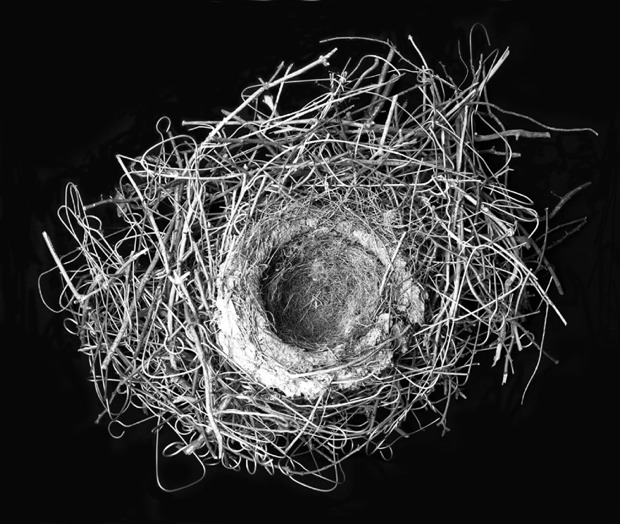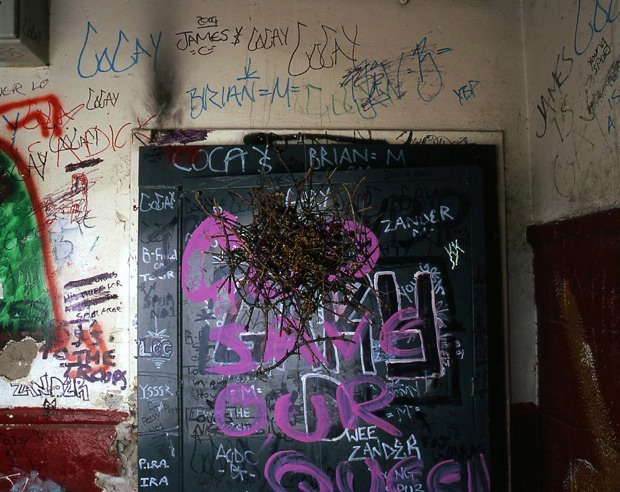Animal Architecture
2006
Slide installation featuring 50 images ( 24 mins 10 secs)
16mm film, mute, 11 mins 24 secs, looped.
Three handmade banners, 300cm x 75cm each
Exhibited at the Hunterian Museum, Glasgow
Supported by the AHRC as part of an Arts and Science Award.
‘Animal Architecture’ is the result of a collaboration between the artist Mark Neville, and scientists from the University of Glasgow’s Institute of Biomedical and Life Sciences.
Part of the exhibition focused on Neville’s collaboration with Dr. Kathryn Arnold, whose cutting edge research examines how Budgerigars fluoresce ( this is only visible to us under ultraviolet light), and how this fluorescence is used to attract a mate. The idea that sexual attractiveness in the animal world can be quantified scientifically, (and in this case visualised through films and photographs taken under a uv light), seems itself to be a contradiction..Together, Dr. Arnold and Neville extended this contemporary research into fluorescent signalling amongst budgerigars, by making the first ever high-speed (slow motion) film, under ultraviolet light, of live Budgerigars as they fluoresce and attract one another.
The aim of the collaboration was to make images that address issues relevant to both scientific and artistic investigation, and therefore have value both as ‘forensic’ documentation, but also as artworks that deal with issues pertaining to representation.
The second part of the show ( also looking at bird behaviour ), consisted of a dramatic interpretation, in the form of a slide show, of the bird nest archive at the Biomedical department. Professor Mike Hansell, a leading expert on animal architecture, has established the largest collection of Birds nests anywhere in Britain. As part of Neville’s artwork, some two hundred of these nests were relocated to Camlachie ( formerly known as Barrowfield), a part of the East end of Glasgow that is currently undergoing profound regeneration with assistance from the West of Scotland Housing Association. It is an area synonymous in the past with the most extreme rival gang warfare..Today, however, many of the council housing estates in the area are about to be demolished, the families having been moved out and rehoused to superior accomodation elsewhere. What is left are empty living spaces that still have an echo of their previous inhabitants, through the wallpaper, abandoned toys, and discarded cds.
The abandoned bird nests that constitute the collection at the university seem to be metaphors for these spaces in Camlachie, and by relocating the nests to these empty houses, and photographing them in different configurations and arrangements in these actual spaces, Neville made a visually dramatic statement that comments both on the role of ‘the archive’, and on gentrification.
The slides themselves were later made available at two different locations only; the Biomedical Department of Glasgow University ( where they are being used by students interested in examining bird behaviour and animal architecture ), and a local community centre in Glasgow’s east end, where the same slides serve a totally different purpose ( as a social document of housing in the area, and a nostalgic function for local residents who have since been rehoused ).
The third and final element of the show consisted of three large banners depicting scenes taken from Hieronymous Bosch’s ‘Garden of Earthly Delights’. The banners were made by local seamstresses, entirely from discarded fabric, bath mats, and old clothes which the artist found in and around Parkhead Football stadium.
The work investigates how different types and genres of photographic practice align themselves with different demographic boxes.
IN THE PRESS

Selected works from the series

‘Magpie nest, 132 Barrowfield Street’ from the slide installation ‘Animal Architecture’, Mark Neville, 2006

‘Reed Warbler nest, 141 Stamford Street’ from the slide installation ‘Animal Architecture’, Mark Neville, 2006

‘Wood pigeon nest, 120 Stamford Street’ from the slide installation ‘Animal Architecture’, Mark Neville, 2006

232 barrowfield street featuring nests made by a Wood Pigeon,Song Thrush, Hawfinch, Golden Oriole, and Siskin’, Mark Neville, 2006

‘Budgerigars under Ultraviolet Light’ ( copyright Mark Neville, 2006, Inkjet prints 100cm x 100cm)

‘Budgerigars under Ultraviolet Light’ ( copyright Mark Neville, 2006, Inkjet prints 100cm x 100cm)

‘Budgerigars under Ultraviolet Light’ ( copyright Mark Neville, 2006, Inkjet prints 100cm x 100cm)

Installation Shot

Banner, Hunterian Museum, Mark Neville, 2006

Slide show, Hunterian Museum, Mark Neville, 2006

Context

Underground poster publicity in Glasgow, Mark Neville, 2006
